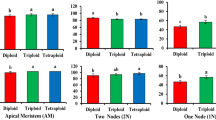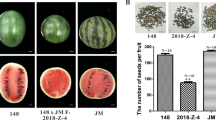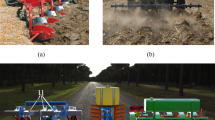Abstract
Seedless watermelon production relies on triploid cultivation or the application of plant growth regulators. However, challenges such as chromosomal imbalances in triploid varieties and concerns about food safety with growth regulator application impede progress. To tackle these challenges, we developed a sexually and vegetatively reproducible inducer line of diploid seedless watermelon by disrupting the double fertilization process. This innovative approach has enabled the successful induction of diploid seedless watermelon across diverse varieties.
This is a preview of subscription content, access via your institution
Access options
Access Nature and 54 other Nature Portfolio journals
Get Nature+, our best-value online-access subscription
$32.99 / 30 days
cancel any time
Subscribe to this journal
Receive 12 digital issues and online access to articles
$119.00 per year
only $9.92 per issue
Buy this article
- Purchase on SpringerLink
- Instant access to full article PDF
Prices may be subject to local taxes which are calculated during checkout


Similar content being viewed by others
Data availability
All data generated in this study are presented in the paper. The data supporting the findings of this study are available within the paper and its Supplementary Information. Source data are provided with this paper.
References
Guo, S. et al. The draft genome of watermelon (Citrullus lanatus) and resequencing of 20 diverse accessions. Nat. Genet. 45, 51–58 (2013).
Varoquaux, F., Blanvillain, R., Delseny, M. & Gallois, P. Less is better: new approaches for seedless fruit production. Trends Biotechnol. 18, 233–242 (2000).
Ainalidou, A., Karamanoli, K., Menkissoglu-Spiroudi, U., Diamantidis, G. & Matsi, T. CPPU treatment and pollination: their combined effect on kiwifruit growth and quality. Sci. Hortic. 193, 147–154 (2015).
Chen, H., Cheng, J., Huang, Y., Kong, Q. & Bie, Z. Comparative analysis of sugar, acid and volatile compounds in CPPU-treated and honeybee-pollinated melon fruits during different developmental stages. Food Chem. 401, 134072 (2023).
Hayata, Y., Niimi, Y. & Iwasaki, N. Synthetic cytokinin-1-(2=chloro=4=pyridyl)-3-phenylurea (CPPU)-promotes fruit set and induces parthenocarpy in watermelon. J. Am. Soc. Hortic. Sci. 120, 997–1000 (1995).
Liu, Y. et al. Gibberellin biosynthesis is required for CPPU-induced parthenocarpy in melon. Hortic. Res. 10, uhad084 (2023).
Feng, Q. et al. Genome-wide analysis of nuclear factor Y genes and functional investigation of watermelon ClNF-YB9 during seed development. Crop J. 11, 1469–1479 (2023).
Cao, L. et al. Disruption of REC8 in meiosis I led to watermelon seedless. Plant Sci. 323, 111394 (2022).
Mori, T., Kuroiwa, H., Higashiyama, T. & Kuroiwa, T. GENERATIVE CELL SPECIFIC 1 is essential for angiosperm fertilization. Nat. Cell Biol. 8, 64–71 (2006).
von Besser, K., Frank, A. C., Johnson, M. A. & Preuss, D. Arabidopsis HAP2 (GCS1) is a sperm-specific gene required for pollen tube guidance and fertilization. Development 133, 4761–4769 (2006).
Wang, W., Xiong, H., Zhao, P., Peng, X. & Sun, M. X. DMP8 and 9 regulate HAP2/GCS1 trafficking for the timely acquisition of sperm fusion competence. Proc. Natl Acad. Sci. USA 119, e2207608119 (2022).
Valansi, C. et al. Arabidopsis HAP2/GCS1 is a gamete fusion protein homologous to somatic and viral fusogens. J. Cell Biol. 216, 571–581 (2017).
Fedry, J. et al. Evolutionary diversification of the HAP2 membrane insertion motifs to drive gamete fusion across eukaryotes. PLoS Biol. 16, e2006357 (2018).
Baquero, E., Fedry, J., Legrand, P., Krey, T. & Rey, F. A. Species-specific functional regions of the green alga gamete fusion protein HAP2 revealed by structural studies. Structure 27, 113–124.e4 (2019).
Wong, J. L., Leydon, A. R. & Johnson, M. A. HAP2(GCS1)-dependent gamete fusion requires a positively charged carboxy-terminal domain. PLoS Genet. 6, e1000882 (2010).
Ezura, K., Nomura, Y. & Ariizumi, T. Molecular, hormonal and metabolic mechanisms of fruit set, the ovary-to-fruit transition, in horticultural crops. J. Exp. Bot. 74, 6254–6268 (2023).
Tamura, K., Stecher, G., Peterson, D., Filipski, A. & Kumar, S. MEGA6: molecular evolutionary genetics analysis version 6.0. Mol. Biol. Evol. 30, 2725–2729 (2013).
Li, X. et al. Arabidopsis DAYU/ABERRANT PEROXISOME MORPHOLOGY9 is a key regulator of peroxisome biogenesis and plays critical roles during pollen maturation and germination in planta. Plant Cell 26, 619–635 (2014).
Feng, Q. et al. Highly efficient, genotype-independent transformation and gene editing in watermelon (Citrullus lanatus) using a chimeric ClGRF4-GIF1 gene. J. Integr. Plant Biol. 63, 2038–2042 (2021).
Chen, X. et al. Creation of a watermelon haploid inducer line via ClDMP3-mediated single fertilization of the central cell. Hortic. Res. 10, uhad081 (2023).
Acknowledgements
We thank W. Yang of Yazhou Bay National Laboratory for providing valuable suggestions for the original manuscript. This work was supported by the National Key Research and Development Program of China (SQ2023YFE0201239 to L.Y.), the National Youth Talent Program (A279021801 to L.Y.), the National Science Foundation of China (32372734 to L.Y.), Earmarked Fund for China Agriculture Research System (CARS-25 to L.Y.), Key-Area R&D Program of Guangdong Province (2022B0202060001 to L.Y.), Key R&D Program of Shaanxi Province (2023-YBNY-008 to L.Y.) and the Natural Science Foundation of Shaanxi Province (2022JM-112 to M.L.).
Author information
Authors and Affiliations
Contributions
L.Y. conceptualized and designed the study, including the experimental framework. X.C., Y.L., G.A. and M.L. carried out the experiments. X.Z., J.W. and S.T. provided project supervision. L.Y. and X.C. collaborated on manuscript writing.
Corresponding author
Ethics declarations
Competing interests
The authors declare no competing interests.
Peer review
Peer review information
Nature Plants thanks Tomoko Igawa, Thomas Lubberstedt and the other, anonymous, reviewer(s) for their contribution to the peer review of this work.
Additional information
Publisher’s note Springer Nature remains neutral with regard to jurisdictional claims in published maps and institutional affiliations.
Supplementary information
Supplementary Information
Supplementary Figs. 1–18 and Tables 1–3.
Source data
Source Data Fig. 1
Statistical source data.
Supplementary Data
Supporting data for Supplementary Table 1 and Fig. 12
Rights and permissions
Springer Nature or its licensor (e.g. a society or other partner) holds exclusive rights to this article under a publishing agreement with the author(s) or other rightsholder(s); author self-archiving of the accepted manuscript version of this article is solely governed by the terms of such publishing agreement and applicable law.
About this article
Cite this article
Chen, X., Li, Y., Liu, M. et al. A sexually and vegetatively reproducible diploid seedless watermelon inducer via ClHAP2 mutation. Nat. Plants 10, 1446–1452 (2024). https://doi.org/10.1038/s41477-024-01799-5
Received:
Accepted:
Published:
Issue date:
DOI: https://doi.org/10.1038/s41477-024-01799-5



